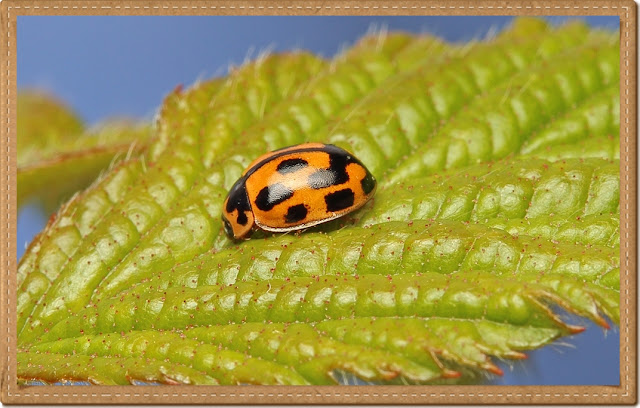These photographs represent hope...hope that this year will be the year when I can at last say for certain that the terrible decline in insect numbers locally, has turned a corner.
They were all taken on one short walk in local woodland about a week ago and although I don't have photographic evidence of everything I saw that day, I am convinced that in total, I spotted more bugs and insects, both in terms of numbers and species, than I have seen in....well, possibly years!
I hope you enjoy the images I do have, as much as I enjoyed finding and sharing them...
Let's begin with this super Mottled Umber caterpillar...
Swiftly followed by my very first Damselfly of 2024 - a Large Red (Pyrrhosoma nymphula) which is our most common Damselfly in the UK. This is a female.
And a dorsal (overhead) view...
Next is this 14-spot Ladybird (Propylea quattuordecimpunctata)
I don't think I have seen one this dark in colour before; even though they can be quite variable. Perhaps this one is fresh, as I believe that fresh adults tend to be more deeply coloured than older ones...
And then our only vegetarian ladybird: Subcoccinella vigintiquatuorpunctata; a 24 Spot Ladybird. This one is very small at 3 or 4mm and is also, strangely, hairy!
I have been finding quite a number of these striking Acorn Weevils in the woods; but not too many females, like this one. Females have the huge rostrum that seems to be equal in length to their body. The female uses the long rostrum (snout) to bore into the centre of an acorn to lay her egg. The larva feeds within the acorn and eventually bores its way out.
The same goes for this next beetle: my photographs are not really clear enough for me to be confident (although I am sure others may well be able to tell). If pushed, I might plump for 'Anaspis' species, and who in their right mind doesn't enjoy a good plump!
I am confident of this beautiful, red beetle though. A Red-headed Cardinal Beetle (Pyrochroa serraticornis). There is a black-headed version, which I also find in these woods from time to time, but it is less commonplace.
Again, this beetle has proved to be elusive regards completing a confident ID. It was tiny, I can vouch for that fact.
This one is far more familiar to me. 'Cassida vibex' - The Tortoise Beetle.
A Female St Mark's fly, or 'Hawthorn fly. (Bibio marci)
St. Mark’s Flies are so called because they emerge around St Mark’s Day, on 25th April every year, and can be seen in flight in May. They are found around woodland edges, hedges, rough grassland and wetlands and can be seen throughout the UK in spring.
I'm afraid that this is another fly that I cannot put a name to, but it may be Brian??
'Myathropa florea': a Hoverfly (Female)
This one is a Sawfly. Sawflies are wasp-like insects that are in the suborder 'Symphyta' within the order 'Hymenoptera', alongside ants, bees, and wasps. The common name comes from the saw-like appearance of the ovipositor, which the females use to cut into the plants where they lay their eggs.
I just thought this was kind of cute when I saw it, and so snapped a photo...
"Okay lads, as you know, we are the secret seven. By the way, has anyone seen George? He's always late..."
This huge fly is 'Tachina fera', a Tachinid Fly. It can often be seen in moist and well vegetated locations where it feeds on umbellifers and waterside plants during May to September. The larvae are parasites of caterpillars, and if you'd like the full, gory details, they eat the caterpillar from the inside!
Always a pleasure to find these bugs. This one is a Rhopalid bug - 'Rhopalus subrufus'. This species is (thankfully) relatively easy to identify from a photograph.
This final photograph shows just how hairy they are...
A couple of plant bugs now. 'Harpocera thoracica' is a rather common species (even so, I had not seen one in these woods for many years until now). I've occasionally heard them called Handsome Plant Bugs. This is the male...
And this second bug is actually the same species, but this is a female...
But what about this strange looking bug, I hear you cry? You didn't? Oh well, I shall tell you anyway, it is yet again the same species. But this is a final instar nymph...
From Plant Bugs to Shieldbugs: This is 'Eurydema oleracea' a Brassica Bug, sometimes called a cabbage bug. They come in a few colourways; I found the black and cream, and also the black and red versions.
Spring in this part of the world, wouldn't really be spring without the omnipresent Dock Bugs (Coreus marginatus). People tend to think that these are Shieldbugs, but actually, they are Squashbugs (Coreidae family).
And so, you knew that eventually we would arrive at the spiders right? I saved them until last, so as to not frighten you away at the start of this update, but now it's their time.
This handsome fellow is 'Araneus triguttatus' A Deciduous Orb-weaver Spider.
I won't bore you with exact ID's for all of the following spiders: even if I could remember them!
Let's just leave it as Crab Spiders, and mostly, if not solely, 'Xysticus' species...
Followed by this smashing little green spider; loosely referred to as a Cucumber Spider. Probably 'Araniella cucurbitina'
And a Long-jawed Orb-weaver (Tetragnatha sp.)
And finally, a spider I have not seen or recorded before, and so this was another nice find. (Pachygnatha sp. Probably P. clercki).
Well this feels like quite a full and fairly extensive update, and so I'll bid you farewell...


%20%20%20BLOG.jpg)


















%20%20%20BLOG.jpg)







%20%20%20BLOG.jpg)
%20POSS.jpg)















No comments:
Post a Comment